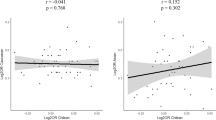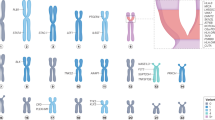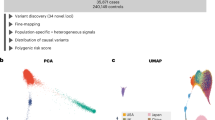Abstract
The aim of this study was to explore the role of vitamin D in rheumatoid arthritis (RA) pathogenesis by investigating the enrichment of vitamin D response elements (VDREs) in confirmed RA susceptibility loci and testing variants associated with vitamin D levels for association with RA. Bioinformatically, VDRE genomic positions were overlaid with non-HLA (human leukocyte antigen)-confirmed RA susceptibility regions. The number of VDREs at RA loci was compared to a randomly selected set of genomic loci to calculate an average relative risk (RR). Single-nucleotide polymorphisms (SNPs) in the DHCR7/NADSYN1 (nicotinamide adenine dinucleotide synthase 1) and CYP2R1 loci, previously associated with circulating vitamin D levels, were tested in UK RA cases (n=3870) and controls (n=8430). Significant enrichment of VDREs was seen at RA loci (P=9.23 × 10−8) when regions were defined either by gene (RR 5.50) or position (RR 5.86). SNPs in the DHCR7/NADSYN1 locus showed evidence of positive association with RA, rs4944076 (P=0.008, odds ratio (OR) 1.14, 95% confidence interval (CI) 1.03–1.24). The significant enrichment of VDREs at RA-associated loci and the modest association of variants in loci-controlling levels of circulating vitamin D supports the hypothesis that vitamin D has a role in the development of RA.
This is a preview of subscription content, access via your institution
Access options
Subscribe to this journal
Receive 6 digital issues and online access to articles
$119.00 per year
only $19.83 per issue
Buy this article
- Purchase on Springer Link
- Instant access to full article PDF
Prices may be subject to local taxes which are calculated during checkout

Similar content being viewed by others
References
Holick MF . Vitamin D deficiency. N Engl J Med 2007; 357: 266–281.
Holick MF . Resurrection of vitamin D deficiency and rickets. J Clin Invest 2006; 116: 2062–2072.
DeLuca HF . Overview of general physiologic features and functions of vitamin D. Am J Clin Nutr 2004; 80 (Suppl 6): 1689S–1696S.
Holick MF . High prevalence of vitamin D inadequacy and implications for health. Mayo Clin Proc 2006; 81: 353–373.
McInnes IB, O'Dell JR . State-of-the-art: rheumatoid arthritis. Ann Rheum Dis 2010; 69: 1898–1906.
Cippitelli M, Santoni A . Vitamin D3: a transcriptional modulator of the interferon-gamma gene. Eur J Immunol 1998; 28: 3017–3030.
DeLuca HF, Cantorna MT . Vitamin D: its role and uses in immunology. FASEB J 2001; 15: 2579–2585.
Griffin MD, Lutz WH, Phan VA, Bachman LA, McKean DJ, Kumar R . Potent inhibition of dendritic cell differentiation and maturation by vitamin D analogs. Biochem Biophys Res Commun 2000; 270: 701–708.
Griffin MD, Lutz W, Phan VA, Bachman LA, McKean DJ, Kumar R . Dendritic cell modulation by 1alpha,25 dihydroxyvitamin D3 and its analogs: a vitamin D receptor-dependent pathway that promotes a persistent state of immaturity in vitro and in vivo. Proc Natl Acad Sci USA 2001; 98: 6800–6805.
Boonstra A, Barrat FJ, Crain C, Heath VL, Savelkoul HFJ, O'Garra A . 1{alpha},25-Dihydroxyvitamin D3 has a direct effect on naive CD4+ T cells to enhance the development of Th2 cells. J Immunol 2001; 167: 4974–4980.
Stockinger B . Th17 cells: an orphan with influence. Immunol Cell Biol 2007; 85: 83–84.
Xue ML, Zhu H, Thakur A, Willcox M . 1 alpha,25-Dihydroxyvitamin D3 inhibits pro-inflammatory cytokine and chemokine expression in human corneal epithelial cells colonized with Pseudomonas aeruginosa. Immunol Cell Biol 2002; 80: 340–345.
Laragione T, Shah A, Gulko PS . The vitamin D receptor regulates rheumatoid arthritis synovial fibroblast invasion and morphology. Mol Med 2012; 18: 194–200.
Ascherio A, Munger KL, Simon KC . Vitamin D and multiple sclerosis. Lancet Neurol 2010; 9: 599–612.
Mathieu C, Gysemans C, Giulietti A, Bouillon R . Vitamin D and diabetes. Diabetologia 2005; 48: 1247–1257.
Pappa HM, Grand RJ, Gordon CM . Report on the vitamin D status of adult and pediatric patients with inflammatory bowel disease and its significance for bone health and disease. Inflamm Bowel Dis 2006; 12: 1162–1174.
Als OS, Riis B, Christiansen C . Serum concentration of vitamin D metabolites in rheumatoid arthritis. Clin Rheumatol 1987; 6: 238–243.
Merlino LA, Curtis J, Mikuls TR, Cerhan JR, Criswell LA, Saag KG . Vitamin D intake is inversely associated with rheumatoid arthritis: results from the Iowa Women's Health Study. Arthritis Rheum 2004; 50: 72–77.
Costenbader KH, Feskanich D, Holmes M, Karlson EW, ito-Garcia E . Vitamin D intake and risks of systemic lupus erythematosus and rheumatoid arthritis in women. Ann Rheum Dis 2008; 67: 530–535.
Haga HJ, Schmedes A, Naderi Y, Moreno AM, Peen E . Severe deficiency of 25-hydroxyvitamin D(3) (25-OH-D (3)) is associated with high disease activity of rheumatoid arthritis. Clin Rheumatol (e-pub ahead of print 15 January 2013; doi:10.1007/s10067-012-2154-6).
Kostoglou-Athanassiou I, Athanassiou P, Lyraki A, Raftakis I, Antoniadis C . Vitamin D and rheumatoid arthritis. Ther Adv Endocrinol Metab 2012; 3: 181–187.
Baykal T, Senel K, Alp F, Erdal A, Ugur M . Is there an association between serum 25-hydroxyvitamin D concentrations and disease activity in rheumatoid arthritis? Bratisl Lek Listy 2012; 113: 610–611.
Higgins MJ, Mackie SL, Thalayasingam N, Bingham SJ, Hamilton J, Kelly CA . The effect of vitamin D levels on the assessment of disease activity in rheumatoid arthritis. Clin Rheumatol (e-pub ahead of print 23 January 2013; doi: 10.1007/s10067-013-2174-x).
Song GG, Bae SC, Lee YH . Association between vitamin D intake and the risk of rheumatoid arthritis: a meta-analysis. Clin Rheumatol 2012; 31: 1733–1739.
Rossini M, Maddali BS, La MG, Minisola G, Malavolta N, Bernini L et al. Vitamin D deficiency in rheumatoid arthritis: prevalence, determinants and associations with disease activity and disability. Arthritis Res Ther 2010; 12: R216.
Ramagopalan SV, Heger A, Berlanga AJ, Maugeri NJ, Lincoln MR, Burrell A et al. A ChIP-seq defined genome-wide map of vitamin D receptor binding: associations with disease and evolution. Genome Res 2010; 20: 1352–1360.
Eyre S, Bowes J, Diogo D, Lee A, Barton A, Martin P et al. High-density genetic mapping identifies new susceptibility loci for rheumatoid arthritis. Nat Genet 2012; 44: 1336–1340.
Cooper JD, Smyth DJ, Walker NM, Stevens H, Burren OS, Wallace C et al. Inherited variation in vitamin D genes is associated with predisposition to autoimmune disease type 1 diabetes. Diabetes 2011; 60: 1624–1631.
Hingorani A, Humphries S . Nature's randomised trials. Lancet 2003; 366: 1906–1908.
Pomerantz MM, Ahmadiyeh N, Jia L, Herman P, Verzi MP, Doddapaneni H et al. The 8q24 cancer risk variant rs6983267 shows long-range interaction with MYC in colorectal cancer. Nat Genet 2009; 41: 882–884.
Wang TJ, Zhang F, Richards JB, Kestenbaum B, van Meurs JB, Berry D et al. Common genetic determinants of vitamin D insufficiency: a genome-wide association study. Lancet 2010; 376: 180–188.
Martin P, Barton A, Eyre S . ASSIMILATOR: a new tool to inform selection of associated genetic variants for functional studies. Bioinformatics 2011; 27: 144–146.
Veyrieras JB, Kudaravalli S, Kim SY, Dermitzakis ET, Gilad Y, Stephens M et al. High-resolution mapping of expression-QTLs yields insight into human gene regulation. PLoS Genet 2008; 4: e1000214.
Raychaudhuri S, Plenge RM, Rossin EJ, Ng AC, Purcell SM, Sklar P et al. Identifying relationships among genomic disease regions: predicting genes at pathogenic SNP associations and rare deletions. PLoS Genet 2009; 5: e1000534.
The Wellcome Trust Case Control Consortium. Genome-wide association study of 14,000 cases of seven common diseases and 3,000 shared controls. Nature 2007; 447: 661–678.
Price AL, Patterson NJ, Plenge RM, Weinblatt ME, Shadick NA, Reich D . Principal components analysis corrects for stratification in genome-wide association studies. Nat Genet 2006; 38: 904–909.
Acknowledgements
We thank Arthritis Research UK for their support (grant ref 17552). This work was supported by the innovative medicines initiative joint undertaking (IMI JU) funded project BeTheCure, (contract number 115142-2).
Author contributions
Conception and design of study: AY, SE, AB; acquisition and analysis of data: AY, PM, ML, JB; interpretation of data: AY, PM; manuscript preparation: AY, PM, SE, AB, JW.
Author information
Authors and Affiliations
Corresponding author
Ethics declarations
Competing interests
The authors declare no conflict of interest.
Additional information
Supplementary Information accompanies this paper on Genes and Immunity website
Supplementary information
Rights and permissions
About this article
Cite this article
Yarwood, A., Martin, P., Bowes, J. et al. Enrichment of vitamin D response elements in RA-associated loci supports a role for vitamin D in the pathogenesis of RA. Genes Immun 14, 325–329 (2013). https://doi.org/10.1038/gene.2013.23
Received:
Revised:
Accepted:
Published:
Issue Date:
DOI: https://doi.org/10.1038/gene.2013.23
Keywords
This article is cited by
-
Network analysis of synovial RNA sequencing identifies gene-gene interactions predictive of response in rheumatoid arthritis
Arthritis Research & Therapy (2022)
-
Vitamin D Receptor Polymorphism and DHCR7 Contribute to the Abnormal Interplay Between Vitamin D and Lipid Profile in Rheumatoid Arthritis
Scientific Reports (2019)
-
Genotypic variability based association identifies novel non-additive loci DHCR7 and IRF4 in sero-negative rheumatoid arthritis
Scientific Reports (2017)
-
Vitamin D in rheumatoid arthritis—towards clinical application
Nature Reviews Rheumatology (2016)



